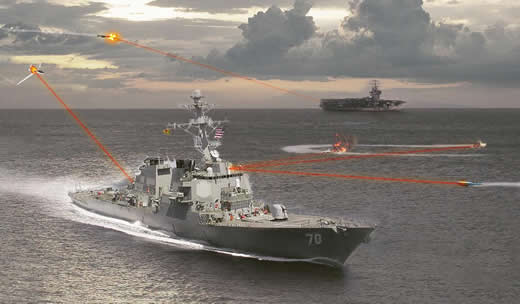
The Free Electron Laser (FEL) program is undergoing Office of Naval Research’s (ONR) preliminary design review (PDR) this week, following the successful critical demonstration of an injector capable generating the electron flow for the megawatt-class FEL laser. “Until now, we didn’t have the evidence to support our models” Dr. Dinh Nguyen, senior project leader for the FEL program at the lab said, confirming that the injector performed as predicted. The team is currently working to measure the properties of the continuous electron beams, in hope to set a world record for the average current of electrons.

The electron laser is generated by passing a beam of high-energy electrons through a series of powerful magnetic fields, generating an intense emission of laser light that can disable or destroy targets. In future shipborne applications the laser will be powered by the ship’s main generator, creating virtually unlimited ammunition. It will provide ultra-precise, speed-of-light defensive weapon capability necessary to meet emerging threats, such as hyper-velocity cruise missiles. Each vessel carrying this weapon will operate a single FEL source feeding up to 10 beam directors, engaging multiple targets simultaneously at different directions, altitudes and ranges.
ONR’s FEL project began as a basic science and technology program in the 1980s and matured into a working 14-kilowatt prototype. In April 2009, the Boeing Company was awarded an Office of Naval Research contract valued at up to $163 million to develop and demonstrate a 100-kW class FEL weapon system. “Two unique attributes of FELs are the ability to tune the wavelength to maximize transmission of the laser through the marine atmosphere, and the ability to aim for a single small spot on the target,” said Ed Pogue, FEL program manager for Boeing. “The combination of these two effects allows the system to destroy the target in the minimum time.”
According to Quentin Saulter, FEL program manager for ONR the team is nine months ahead of schedule to achieve its goals for 2011. The FEL weapon system is set to pass critical design review phase in the fourth quarter of this year, to be followed by additional task orders for fabrication and testing in a laboratory environment. ONR hopes to test the FEL in a maritime environment as early as 2018.
Boeing is partnering on FEL with U.S. Department of Energy laboratories, academia and industry. The laboratories include the Thomas Jefferson National Accelerator Facility in Newport News, Va., the Los Alamos National Laboratory in Los Alamos, N.M., and the Argonne National Laboratory in Chicago. Major industrial partners include Advanced Energy Systems, Niowave Inc. and SAIC.
Related posts: High Power Laser are Maturing into Weapons Grade Systems
















